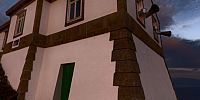© 2007 Ricardo Cambón, All Rights Reserved.
The Lighthouse of Fisterra is very important lighthouse along this Costas da Morte; with it light guide the boats through storms and dangerous waters which contain hidden dangers like reefs and sand banks. The present lighthouse was built in 1868 and is the second most visited place in Galicia after the Cathedral of Santiago. In this area you can also see the church of Santa Maria das Areas, which was built at the end of the XII century. This church contains the XIV century wooden image carved in gothic style of our Lord Christ of Fisterra and in a similar style to the Christ of Burgos and Ourense. In front of the Church was located the Pilgrims Hospital founded by the priest Don Alonso Garcia in 1469. This panoramic view form part of this Project http://www.Galicia360.com/
Al Faro de Fisterra llegan los peregrinos del Camino de Santiago en el final de su viaje a Galicia. Y es tradición la quema de alguna prenda de ropa o de las botas usadas en el camino. Y claro esta, si se puede contenplar una hermosa puesta de sol el final del camino se realiza plenamente.
Faro de Fisterra El Faro más importante de esta Costa da Morte, pues con su luz guía a los barcos en su navegación por estas aguas peligrosas por los temporales que se producen y los bajos o arrecifes que existen y pueden causar el naufragio de las embarcaciones. El edificio actual es de 1868 y es el lugar más visitado de Galicia después de la Catedral de Santiago. También se construyó a finales del S. XII la iglesia de Santa María das Areas y donde se encuentra la imagen del Santo Cristo de Fisterra Talla gótica del S. XIV y de estilo similar al Santo Cristo de Burgos y de Ourense. Frente a la Iglesia se encontraba el hospital de peregrino, fundado por el párroco D. Alonso García en 1469. La panorámica forma parte del proyecto http://www.Galicia360.com



 Tap or click the zoom icon in the bottom right corner of the picture to switch between in-page and fullscreen view
Tap or click the zoom icon in the bottom right corner of the picture to switch between in-page and fullscreen view